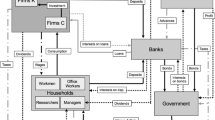Abstract
We present a model that links the division of labor and economic growth with the division of wealth in society. When capital market imperfections restrict the access of poor households to capital, the division of wealth affects individual incentives to invest in specialization. In turn, the division of labor determines the dynamics of the wealth distribution. A highly concentrated distribution of wealth leads to a low degree of specialization, low productivity, and low wages. In that case workers are unable to accumulate enough wealth to invest in specialization. Hence, in a highly unequal society, there is a vicious cycle in which the degree of specialization, productivity and wages stay low, wealth and income inequality stays high and the economy stagnates. By contrast, greater equality increases investment in specialization and leads to a greater division of labor and higher long run development.
Similar content being viewed by others
References
Aghion, P., and P. Bolton. (1997). “A Theory of Trickle Down Growth and Development,” Review of Economic Studies 64, 151–172.
Aghion, P., E. Caroli, and C. Garcia-Penalosa. (1999). “Inequality and Economic Growth: The Perspective of the New Growth Theories,” Journal of Economic Literature 37, 1615–1660.
Atkinson, A., and M. Ogaki. (1996). “Wealth-Varying Intertemporal Elasticities of Substitution: Evidence from Panel and Aggregate Data,” Journal of Monetary Economics 38, 507–534.
Baldwin, R. E., P. Martin, and G. I. P. Ottaviano. (2001). “Global Income Divergence, Trade and Industrialization: The Geography of Growth Take-Offs,” Journal of Economic Growth, 6, 5–37.
Banerjee, A., and A. Newman. (1993). “Occupational Choice and the Process of Development,” Journal of Political Economy 101, 274–298.
Barro, R. (2000). “Inequality and Growth in a Panel of Countries,” Journal of Economic Growth 5, 5–32.
Becker, G. S., and K. M. Murphy. (1992). “The Division of Labor, Coordination Costs and Knowledge,” Quarterly Journal of Economics 107, 1137–1160.
Benabou, R. (1996). “Inequality and Growth.” NBER Macroeconomics Annual. MIT Press, pp. 11–74.
Bourguignon, F. (1981). “Pareto Superiority of Unegalitarian Equilibria in Stiglitz's Model of Wealth Distribution with Convex Saving Function,” Econometrica 49(6), 1469–1475.
Dynan, K. E., J. Skinner, and S. Zeldes. (1996). “Do the rich save more?” Mimeo.
Fershtman, C., and E. Kalai. (1993). “Complexity Considerations and Market Behavior,” Rand Journal of Economics 24(2), 224–235.
Forbes, K. (2000). “A Reassessment of the Relationship Between Inequality and Growth,” American Economic Review 90, 869–887.
Galor, O., and O. Moav. (1999). “From Physical to Human Capital Accumulation: Inequality in the Process of Development,” CEPR discusion paper #2307.
Galor, O., and J. Zeira. (1993). “Income Distribution and Macroeconomics,” Review of Economic Studies 60, 35–52.
Goodfriend, M., and J. McDermott. (1995). “Early Development,” American Economic Review 85, 116–133.
Helpman, E., and G. Grossman. (1993). Innovation and Growth in the Global Economy. MIT Press.
Kaldor, N. (1956). “Alternative Theories of Distribution,” Review of Economic Studies 23, 83–100.
Kelly, M. (1997). “The Dynamic of Smithian Growth,” Quarterly Journal of Economics 112, 939–964.
Kelly, M. (2001). “Linkages, Thresholds, and Development,” Journal of Economic Growth 6(1), 39–53.
Keynes, J. M. (1920). The Economic Consequences of the Peace. Macmillan and Co.
Kuznets, S. (1955). “Economic Growth and Income Inequality,” American Economic Review 45, 1–28.
Menchik, P. L., and M. David. (1983). “Income Distribution, Life Time Earnings and Bequests,” American Economic Review 73, 672–690.
Moav, O. (2002). “Income Distribution and Macroeconomics: The Persistence of Inequality in a Convex Technology Framework,” Economics Letters 75, 187–192.
Perotti, R. (1996). “Growth, Income Distribution, and Democracy: What the Data Say,” Journal of Economic Growth 1, 149–187.
Piketty, T. (1997). “The Dynamics of the Wealth Distribution and the Interest Rate with Credit Rationing,” Review of Economic Studies 64, 173–189.
Romer, P. M. (1987). “Growth Based on Increasing Returns Due to Specialization,” American Economic Review 77, 56–62.
Stigler, G. (1951). “The Division of Labor is Limited by the Extent of the Market,” Journal of Political Economy 59, 185–193.
Tomes, N. (1981). “The Family, Inheritance and the Intergenerational Transmission of Inequality,” Journal of Political Economy 89, 928–958.
Author information
Authors and Affiliations
Rights and permissions
About this article
Cite this article
Fishman, A., Simhon, A. The Division of Labor, Inequality and Growth. Journal of Economic Growth 7, 117–136 (2002). https://doi.org/10.1023/A:1015672012193
Issue Date:
DOI: https://doi.org/10.1023/A:1015672012193




